Here are some more city parks named for people in Fort Worth history (see Part 1):
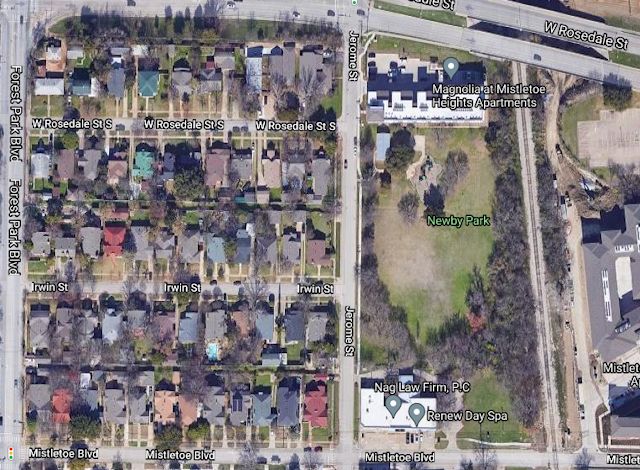 Newby Park is located in Mistletoe Heights.
Newby Park is located in Mistletoe Heights.
 Etta Newby was the widow of William Garland Newby (1859-1916), president of American National Bank. Mrs. Newby was a philanthropist. For example, in 1923 she donated the house on Pennsylvania Avenue on Quality Hill that was the first home of the Woman’s Club of Fort Worth. The club later honored her by forming the Etta Newby Club. In 1930 she donated the chimes for First Methodist Church.
Etta Newby was the widow of William Garland Newby (1859-1916), president of American National Bank. Mrs. Newby was a philanthropist. For example, in 1923 she donated the house on Pennsylvania Avenue on Quality Hill that was the first home of the Woman’s Club of Fort Worth. The club later honored her by forming the Etta Newby Club. In 1930 she donated the chimes for First Methodist Church.
Mrs. Newby also speculated in real estate, including lots in Englewood Heights in Poly.
 She died in 1936.
She died in 1936.
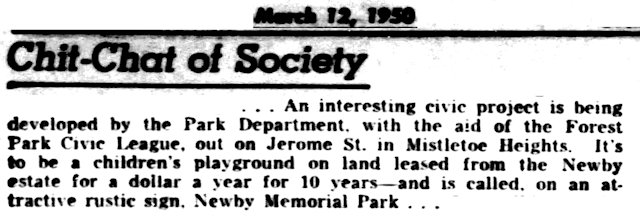 Her estate provided the land for the park.
Her estate provided the land for the park.
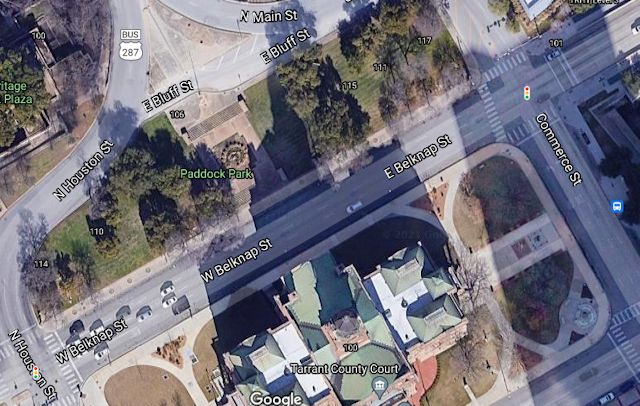 Paddock Park, located between the courthouse and the Paddock Viaduct, is named for B. B. Paddock, who was Fort Worth’s head cheerleader in the nineteenth century and whose newspaper was his megaphone.
Paddock Park, located between the courthouse and the Paddock Viaduct, is named for B. B. Paddock, who was Fort Worth’s head cheerleader in the nineteenth century and whose newspaper was his megaphone.
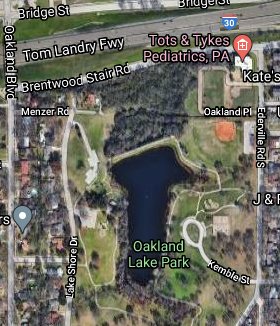 It’s called “Oakland Park” today. But once upon a time it was “Fosdick Lake Park.”
It’s called “Oakland Park” today. But once upon a time it was “Fosdick Lake Park.”
Why “Fosdick”?
According to the Star-Telegram in 1929, in 1909 E. E. Fosdick, a local insurance agent and real estate dealer, bought the property, impounded a lake, and built a clubhouse. He planned to open Inverness Country Club. He rounded up seventy-five members. But when Fosdick died in 1915 plans for the country club died with him. The property came to be called “Fosdick Lake Park.”
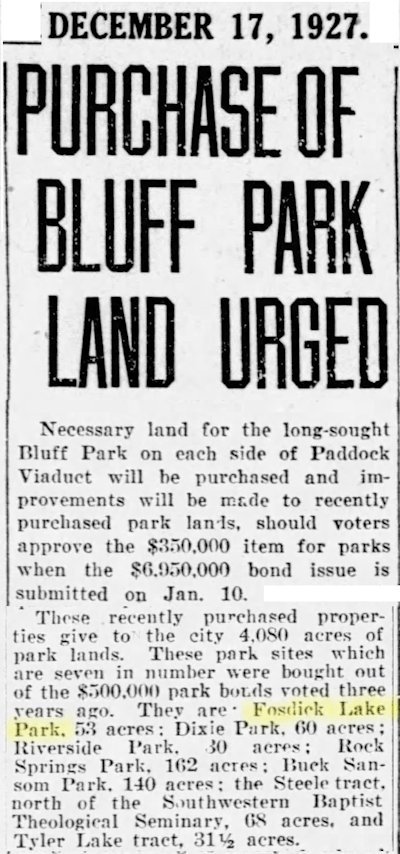
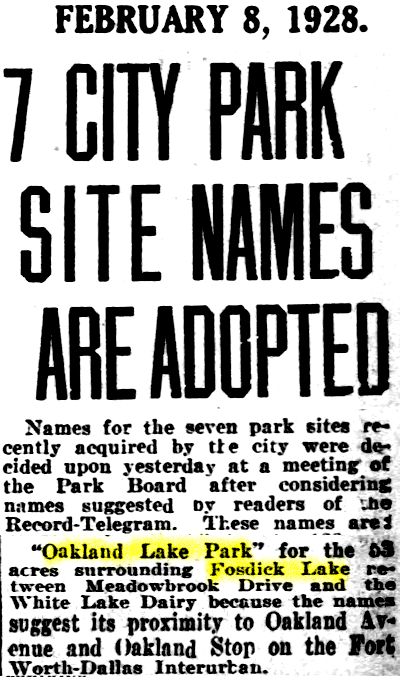 In 1927 the city bought the property and renamed it “Oakland Park” for the nearby boulevard and the Oakland Boulevard stop on the interurban.
In 1927 the city bought the property and renamed it “Oakland Park” for the nearby boulevard and the Oakland Boulevard stop on the interurban.
 Overton Park is located in southwest Fort Worth, where several streets and subdivisions contain the name Overton. That’s because early settlers of the area in 1848 included Lemuel Edwards and his wife, Elizabeth Overton. After Lemuel was murdered by his son-in-law in 1869, Lemuel’s son, Cass Overton Edwards (1851-1941), added to the Edwards property until it totaled thousands of acres.
Overton Park is located in southwest Fort Worth, where several streets and subdivisions contain the name Overton. That’s because early settlers of the area in 1848 included Lemuel Edwards and his wife, Elizabeth Overton. After Lemuel was murdered by his son-in-law in 1869, Lemuel’s son, Cass Overton Edwards (1851-1941), added to the Edwards property until it totaled thousands of acres.
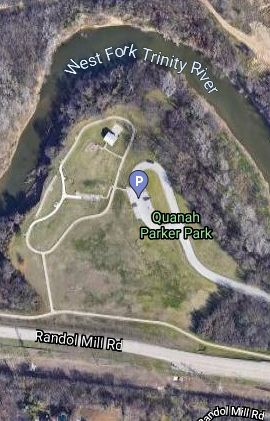 Quanah Parker Park is located in east Fort Worth on the Trinity River.
Quanah Parker Park is located in east Fort Worth on the Trinity River.
 In 1999 the park was named for Comanche chief Quanah Parker, son of Cynthia Ann Parker. Quanah Parker was a friend of Burk Burnett and occasionally visited Fort Worth. He was a featured attraction at the stock show in 1909.
In 1999 the park was named for Comanche chief Quanah Parker, son of Cynthia Ann Parker. Quanah Parker was a friend of Burk Burnett and occasionally visited Fort Worth. He was a featured attraction at the stock show in 1909.
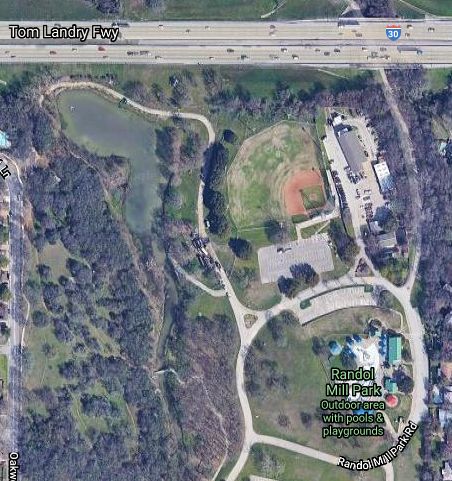 Randol Mill Park in west Arlington, like Randol Mill Drive, is named for the mill that Robert Andrew Randol operated on the Trinity River.
Randol Mill Park in west Arlington, like Randol Mill Drive, is named for the mill that Robert Andrew Randol operated on the Trinity River.
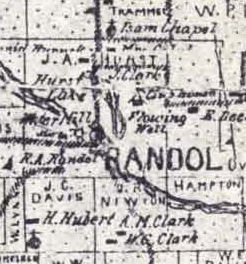 The mill was built about 1856 by Archibald Franklin Leonard. Randol bought the mill in 1876. A community named “Randol” grew up at the mill.
The mill was built about 1856 by Archibald Franklin Leonard. Randol bought the mill in 1876. A community named “Randol” grew up at the mill.
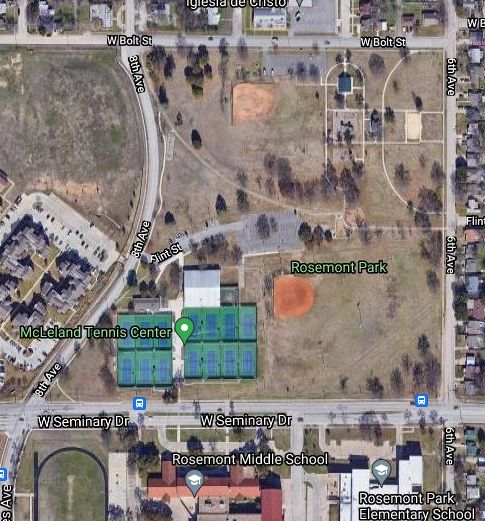
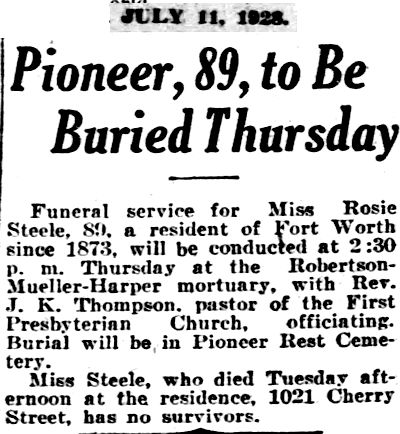 Rosemont Park on West Seminary Drive, the Star-Telegram wrote in 1928, is named for Rosie Steele, who came to Fort Worth in 1873 in a covered wagon, owned sixty-eight acres north of the seminary for fifty-four years, and created a trust by which proceeds from sale of the land would be given to the city.
Rosemont Park on West Seminary Drive, the Star-Telegram wrote in 1928, is named for Rosie Steele, who came to Fort Worth in 1873 in a covered wagon, owned sixty-eight acres north of the seminary for fifty-four years, and created a trust by which proceeds from sale of the land would be given to the city.
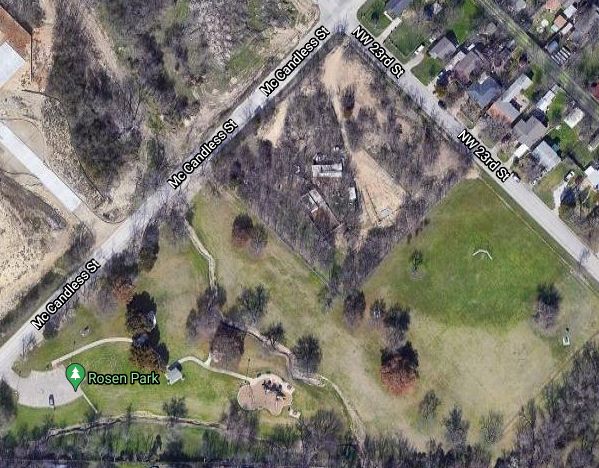 Rosen Park is named for North Side early civic leader and developer Sam Rosen.
Rosen Park is named for North Side early civic leader and developer Sam Rosen.
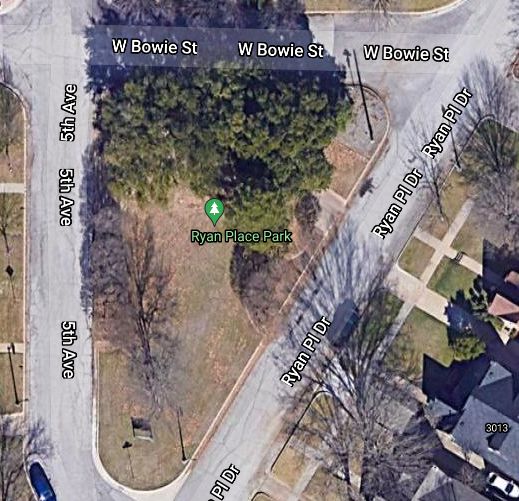 Little triangular Ryan Place Park is named for Ryan Place developer John C. Ryan.
Little triangular Ryan Place Park is named for Ryan Place developer John C. Ryan.
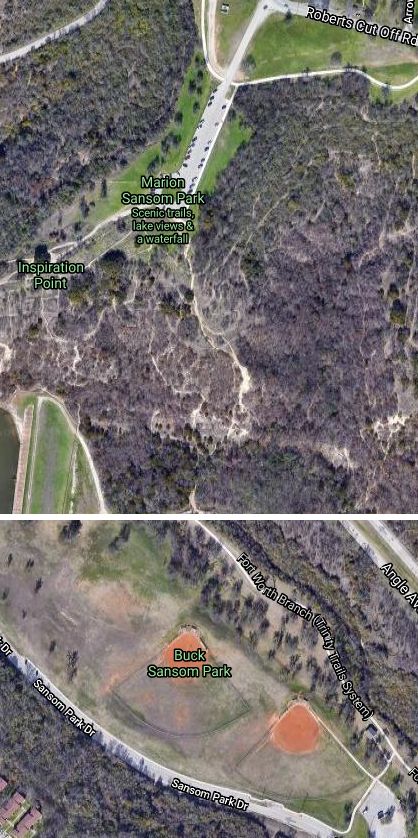 Marion Sansom Park and Buck Sansom Park are located on the North Side. Marion and Buck were father and son. Both were cattlemen who owned hundreds of acres of ranchland around Lake Worth. The two men sold and donated to the city the land for the two parks.
Marion Sansom Park and Buck Sansom Park are located on the North Side. Marion and Buck were father and son. Both were cattlemen who owned hundreds of acres of ranchland around Lake Worth. The two men sold and donated to the city the land for the two parks.
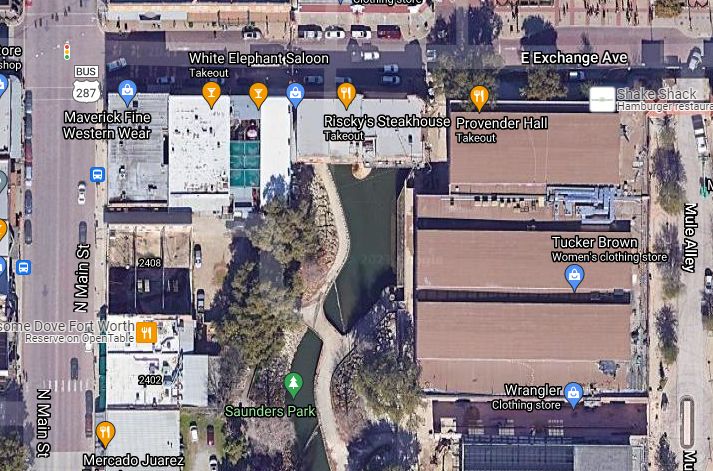
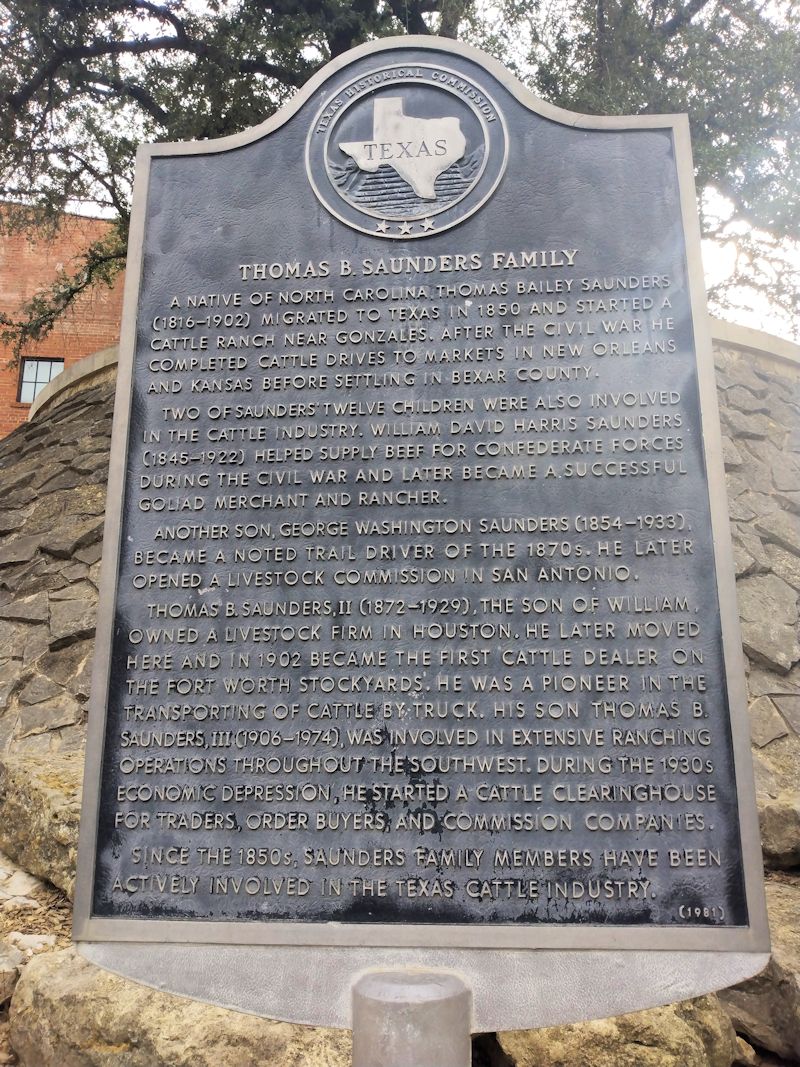 Saunders Park on Marine Creek next to the stockyards is named after the family headed by cattleman Thomas Bailey Saunders.
Saunders Park on Marine Creek next to the stockyards is named after the family headed by cattleman Thomas Bailey Saunders.
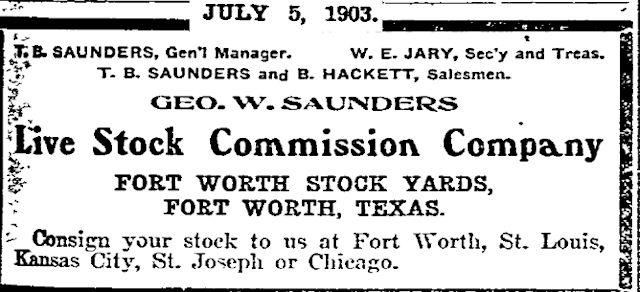 Saunders’s son George Washington Saunders and grandson Thomas B. Saunders II were among the first cattle dealers at the stockyards.
Saunders’s son George Washington Saunders and grandson Thomas B. Saunders II were among the first cattle dealers at the stockyards.
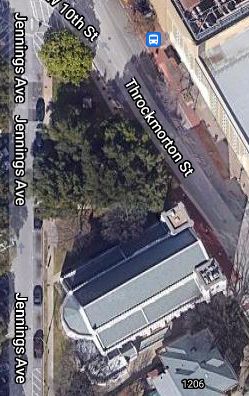
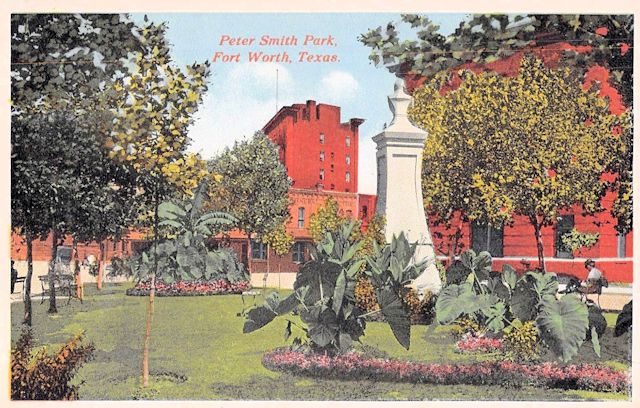 Peter Smith Park is located downtown between Jennings and Throckmorton streets just north of St. Patrick Cathedral.
Peter Smith Park is located downtown between Jennings and Throckmorton streets just north of St. Patrick Cathedral.
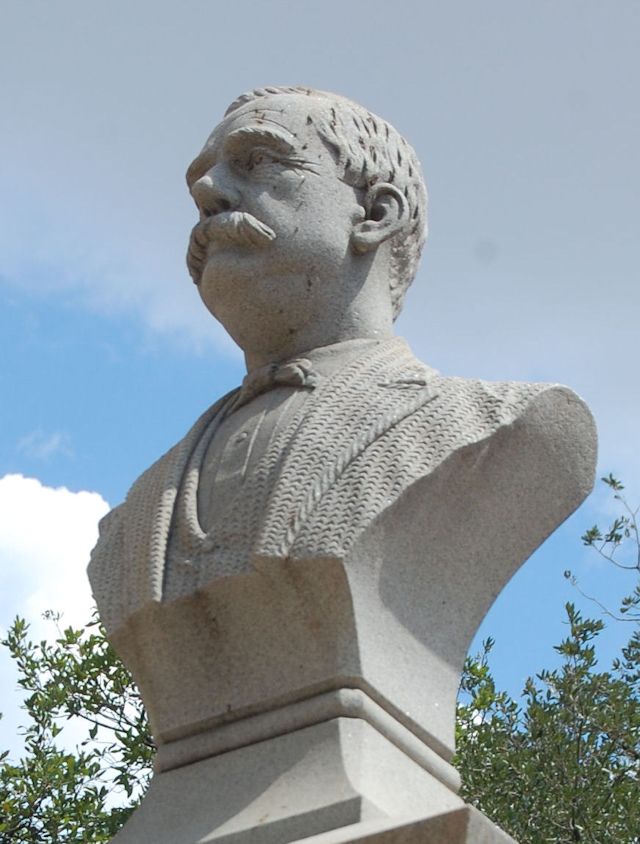 John Peter Smith was a longtime civic leader. A school, a street, and a hospital have been named for him. Father Jean Marie Guyot of St. Patrick’s, a friend of Smith, donated land for the park. Centerpiece of the park is a monument to Smith (his likeness was cast from a death mask).
John Peter Smith was a longtime civic leader. A school, a street, and a hospital have been named for him. Father Jean Marie Guyot of St. Patrick’s, a friend of Smith, donated land for the park. Centerpiece of the park is a monument to Smith (his likeness was cast from a death mask).
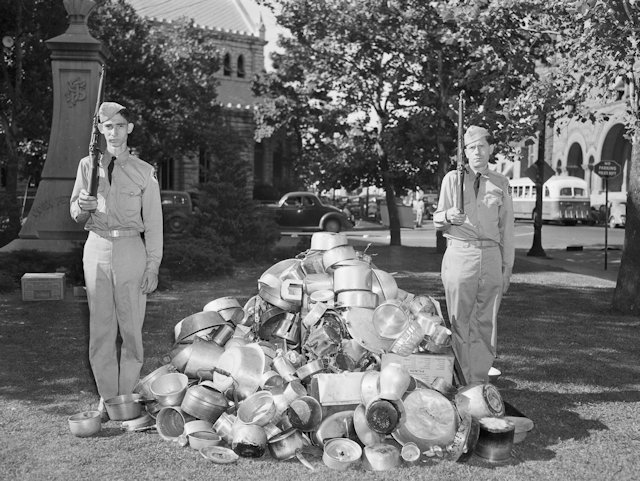 In July 1941—five months before Pearl Harbor—America was already strengthening its national defense program. Peter Smith Park was a donation site for an aluminum drive. This photo shows a pile of pots, pans, and other aluminum containers being guarded by two privates of the Texas Defense Guard. Note the cars in the background. West 11th Street once separated the park and the church, making a triangle of the park. In the right background can be seen the red brick front of the 1896 federal building/post office, which stood until 1963. (Photo from University of Texas at Arlington Library Star-Telegram Collection.)
In July 1941—five months before Pearl Harbor—America was already strengthening its national defense program. Peter Smith Park was a donation site for an aluminum drive. This photo shows a pile of pots, pans, and other aluminum containers being guarded by two privates of the Texas Defense Guard. Note the cars in the background. West 11th Street once separated the park and the church, making a triangle of the park. In the right background can be seen the red brick front of the 1896 federal building/post office, which stood until 1963. (Photo from University of Texas at Arlington Library Star-Telegram Collection.)
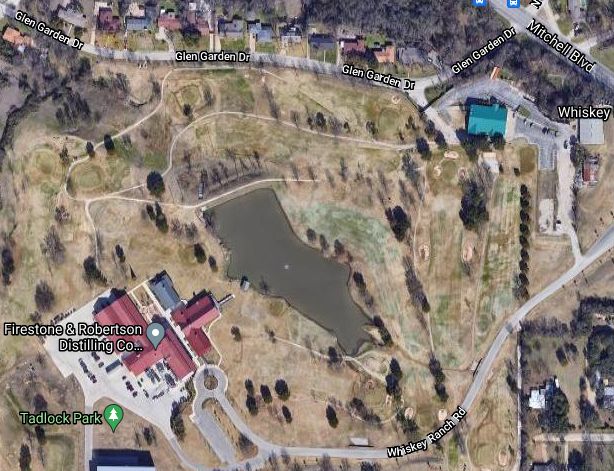 Tadlock Park is located next to Firestone & Robertson Distilling Company (former site of Glen Garden Country Club).
Tadlock Park is located next to Firestone & Robertson Distilling Company (former site of Glen Garden Country Club).
 The land for the park was given to the city by Mutual Savings & Loan Association. The park is named for park board president J. Albert Tadlock Jr.
The land for the park was given to the city by Mutual Savings & Loan Association. The park is named for park board president J. Albert Tadlock Jr.
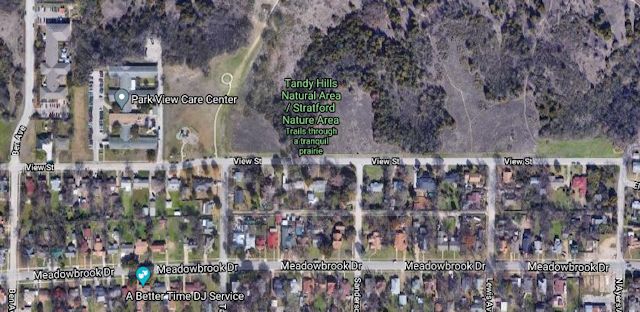 Tandy Hills Natural Area is located in Meadowbrook south of Interstate 30. It is named for a family prominent in East Side history. In 1855 Kentuckian Roger Tandy (1806-1898) settled on a land grant (probably Peters Colony) in what would become the community of Polytechnic. Roger impounded Tandy Lake near the intersection of today’s East Lancaster Avenue and Ayers Street. Roger’s son George was an early civic leader in Poly. (See Hall Tandy Memorial Park in Part 1.)
Tandy Hills Natural Area is located in Meadowbrook south of Interstate 30. It is named for a family prominent in East Side history. In 1855 Kentuckian Roger Tandy (1806-1898) settled on a land grant (probably Peters Colony) in what would become the community of Polytechnic. Roger impounded Tandy Lake near the intersection of today’s East Lancaster Avenue and Ayers Street. Roger’s son George was an early civic leader in Poly. (See Hall Tandy Memorial Park in Part 1.)
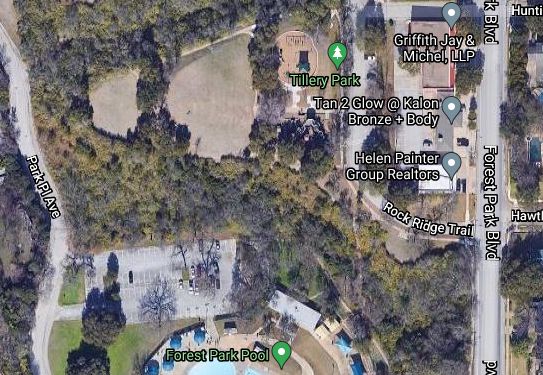 Tillery Park is located just west of Forest Park Boulevard.
Tillery Park is located just west of Forest Park Boulevard.
 It is named for Robert Tillery, whose grocery store on Forest Park Boulevard was a neighborhood institution.
It is named for Robert Tillery, whose grocery store on Forest Park Boulevard was a neighborhood institution.
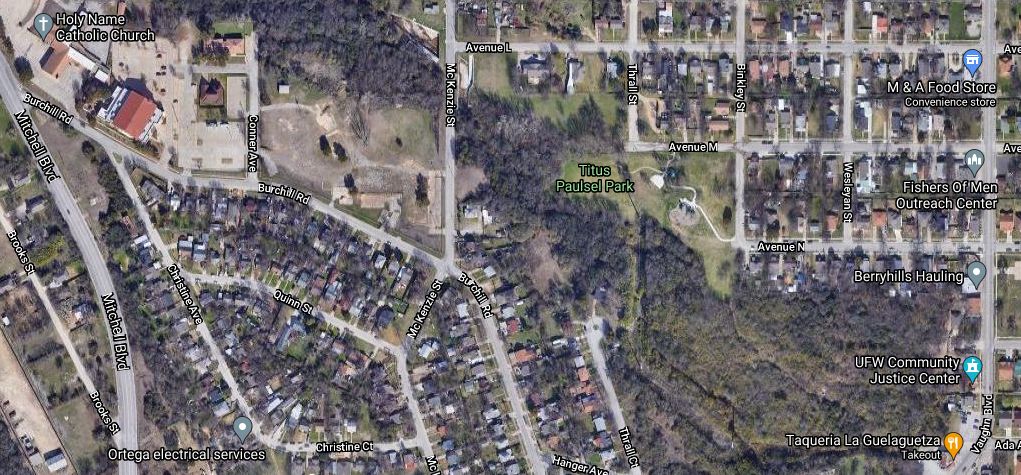 For years I was curious about Titus Paulsel Park. It is located in Poly north of Burchill Road. I was curious because the park is adjacent to the creek where I misspent my youth. The park did not exist when I was a barefoot boy with cheek of tan fishing for crawdads. Who was Titus Paulsel?
For years I was curious about Titus Paulsel Park. It is located in Poly north of Burchill Road. I was curious because the park is adjacent to the creek where I misspent my youth. The park did not exist when I was a barefoot boy with cheek of tan fishing for crawdads. Who was Titus Paulsel?
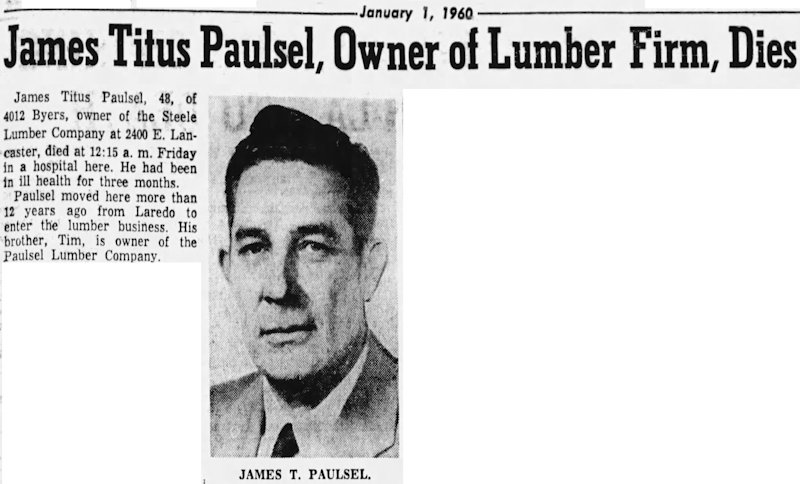 Come to find out, Titus Paulsel was the owner of a lumber company. He also owned seven acres in Poly. After he died in 1960, the land was placed in a trust.
Come to find out, Titus Paulsel was the owner of a lumber company. He also owned seven acres in Poly. After he died in 1960, the land was placed in a trust.
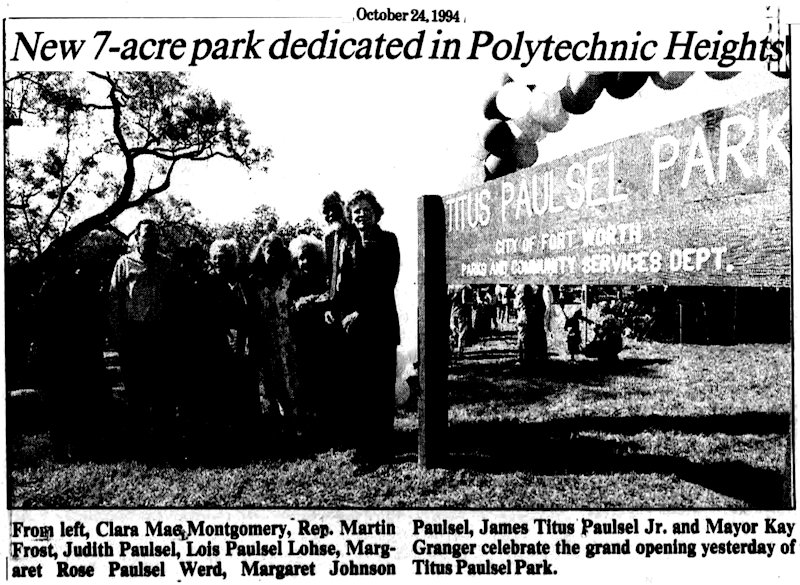 His heirs donated the land for a park, which opened in 1994.
His heirs donated the land for a park, which opened in 1994.
 Worth Square downtown is named, of course, for Fort Worth namesake General William Jenkins Worth.
Worth Square downtown is named, of course, for Fort Worth namesake General William Jenkins Worth.
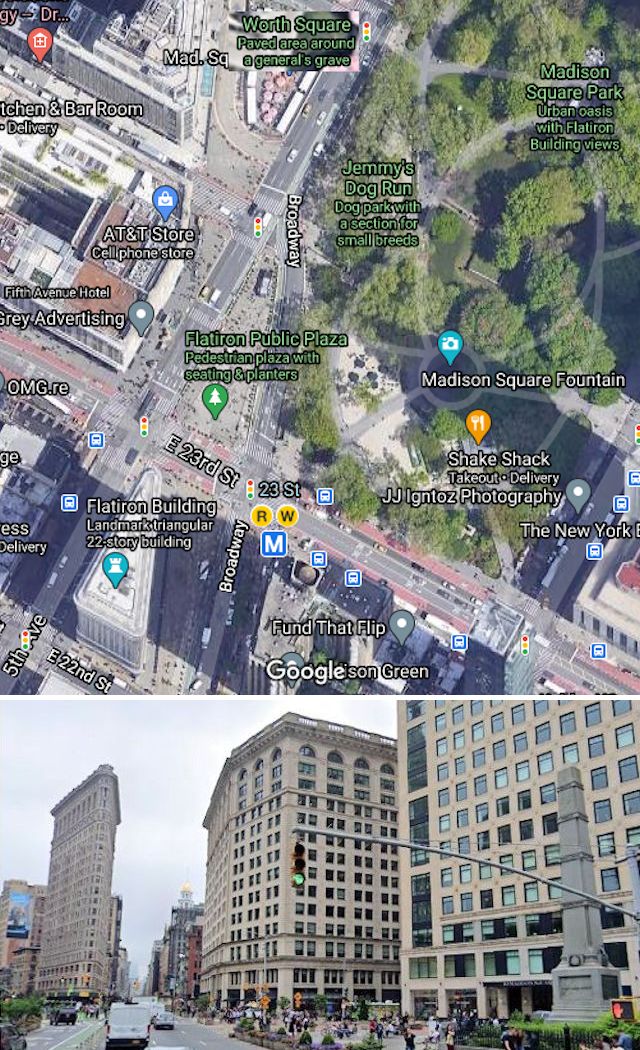 General Worth is buried in Worth Square—the one in New York City.
General Worth is buried in Worth Square—the one in New York City.
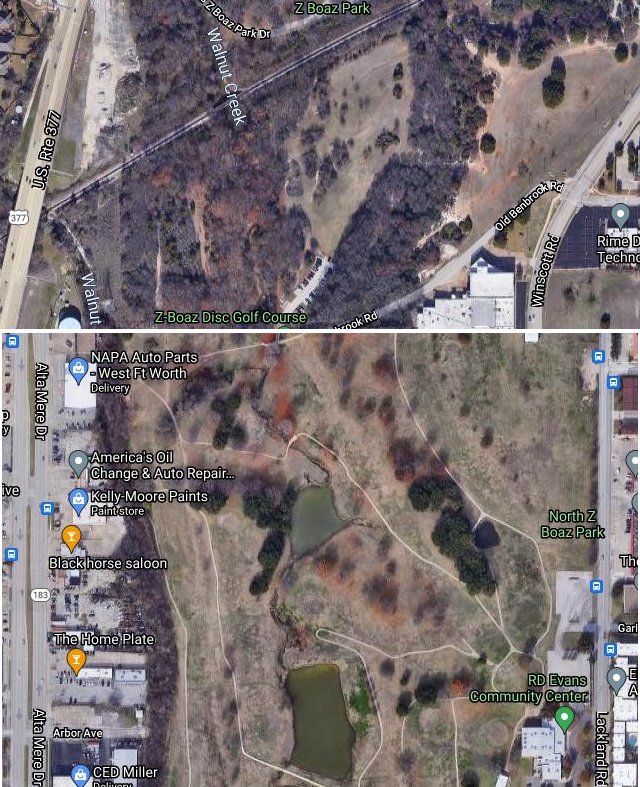 Zachary Boaz (commonly known as “Z. Boaz”) was one of three brothers who were prominent businessmen. Z. Boaz provided land for Z. Boaz Park north of Benbrook and for North Z. Boaz Park, which used to be Z. Boaz golf course.
Zachary Boaz (commonly known as “Z. Boaz”) was one of three brothers who were prominent businessmen. Z. Boaz provided land for Z. Boaz Park north of Benbrook and for North Z. Boaz Park, which used to be Z. Boaz golf course.
Fort Worth’s Street Gang
Cowtown at Play






I love all your stories. Thanks Mike
Thank you, Keith.
Have you found the source of the name for Stephens Park, 2701 W. Gambrell? The park was a “gift” from the water department in the early 1960s (there’s a big water tower in it). My theory is that it was named for Uel Stephens (1893-1976) who was director of the water department from 1942 until his retirement in 1961 but I haven’t found a definitive answer. I’ve looked in park board minutes but haven’t been able to verify. Thanks for your great posts!
Thanks, Susan. I know the “E.T.” park well. And I’ll bet you are right about its namesake. Of course, I found nothing to confirm that in the S-T archives, following in your footsteps (“clipped by sakline2”).